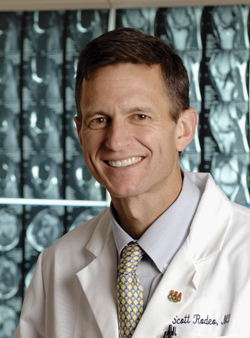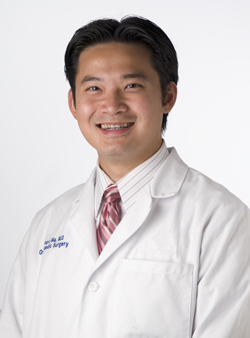Hospital for Special Surgery Investigators Receive National Football League Grant for PRP Research
New York—September 11, 2012
Researchers at Hospital for Special Surgery have been awarded a $100,000 grant from the National Football League (NFL) Charities to research the use of platelet-rich plasma (PRP) and stem cells as treatments for tendon injury and degeneration. For years, PRP has been used to improve healing in various sports injuries, but there is little evidence of its efficacy. Tendon overuse injuries are commonly seen in NFL players and recreational athletes, and new treatments are needed.
 “We don’t have a treatment that works 100 percent of the time, so there is room for improvement,” said Scott Rodeo, M.D., co-chief of the Sports Medicine Service for Hospital for Special Surgery in New York City. “Many people are weekend warriors and they suffer from tendon overuse injuries. Hopefully, our study will be able to help a lot of these people.” Dr. Rodeo will be heading up the research. He has been associate team physician for the New York Football Giants since 2000.
“We don’t have a treatment that works 100 percent of the time, so there is room for improvement,” said Scott Rodeo, M.D., co-chief of the Sports Medicine Service for Hospital for Special Surgery in New York City. “Many people are weekend warriors and they suffer from tendon overuse injuries. Hopefully, our study will be able to help a lot of these people.” Dr. Rodeo will be heading up the research. He has been associate team physician for the New York Football Giants since 2000.
The results of the research could lead to the development of an effective therapeutic strategy for tendinopathy that may allow NFL players to return to competition more quickly. It may also lead to a decrease in complications related to tendinosis, such as tendon ruptures.
Tendinosis is caused by repetitive microtears in the connective tissue in and around the tendon along with a failure of the body to mount a full healing response. Over time it can lead to pain, reduced tensile strength and chance of tendon rupture.
The grant money will be used to investigate how degenerated tendons respond to PRP and bone marrow-derived stem cells as well as if these two treatments will be synergistic if they are combined. Researchers will test these treatments in a preclinical model of tendon injury and degeneration. Among the goals of the research are to examine the structural and mechanical properties of the treated tendon tissue and to see how it responds to PRP and stem cells.
In recent years, physicians have found that some, but not all, patients with tendon disorders respond to treatment with PRP. PRP contains cells and growth factors that may stimulate healing of bone and soft tissue. Researchers surmise the mixed results may be caused by variations in preparation, timing, dosage and delivery of platelets, or differences in bioactivity. Different PRP preparations contain different amounts of cell and growth factors, and the researchers speculate that the negative studies may have used PRP preparations with low bioactivity. To test this theory, researchers will test the bioactivity levels of the preparations used. It is also unclear whether PRP treatments actually help heal the tendon structure or just ameliorate the pain. An examination of tissue should provide an answer to this question.
 “We don’t really understand how PRP affects tendon structure after we place it into patients. Some individuals get pain relief while others do not. The reported clinical results are mixed, “ said Richard Ma, M.D., an orthopedic surgery fellow in the Sports Medicine Service at Hospital for Special Surgery and co-principal investigator for the study. “The advantage of a preclinical research model is we can not only evaluate the effects of PRP on tendon architecture after injury, but we can also evaluate how it might improve the structural strength of these tendons.
“We don’t really understand how PRP affects tendon structure after we place it into patients. Some individuals get pain relief while others do not. The reported clinical results are mixed, “ said Richard Ma, M.D., an orthopedic surgery fellow in the Sports Medicine Service at Hospital for Special Surgery and co-principal investigator for the study. “The advantage of a preclinical research model is we can not only evaluate the effects of PRP on tendon architecture after injury, but we can also evaluate how it might improve the structural strength of these tendons.
Similar to PRP, studies using stem cells to treat tendon disorders have also yielded conflicting results. HSS researchers hope their experiments can tease out how this treatment impacts tendons. “Cell therapies such as bone marrow stem cells are attractive because it may provide the necessary stimulus to overcome the unfavorable biologic microenvironment in chronic tendon degeneration,” said Dr. Ma. Stem cells have the capability of differentiating into diverse specialized cell types.
“We hope the results of our study will identify the important parameters that might improve the efficacy of PRP and stem cell treatments,” said Dr. Ma. “Despite both treatments being readily clinically used, there is still a great deal we do not understand about PRP, stem cells, and how to optimize its composition to improve its efficacy for all patients. With our research proposal, we are hoping to address some of these questions that we have not been able to answer with human clinical studies.”
Dr. Rodeo is also a team physician for USA Olympic Swimming. He just returned from the summer games in London, England.
The NFL Charities support medical research that enhances the body of scientific knowledge that will ultimately benefit all who are actively involved in competitive sports and recreational athletic activities.
About NFL Charities
NFL Charities is a non-profit organization created by the 32 member clubs of the National Football League to enable the teams to collectively make grants to charitable and worthwhile causes on a national scale. Since its inception, NFL Charities has granted more than $148 million to more than 1,400 different organizations. NFL Charities’ primary funding categories include: sports-related medical research and education grants; player foundation grants in support of the philanthropic work of current and former NFL players; financial assistance for former NFL players in need; impact grants to support national youth health and fitness education initiatives as part of a league-wide commitment to fight childhood obesity; and team program grants which supplement the charitable and community activities of the 32 NFL clubs.
Need Help Finding a Physician?
+1.877.606.1555
Media Contacts
212.606.1197
mediarelations@hss.edu